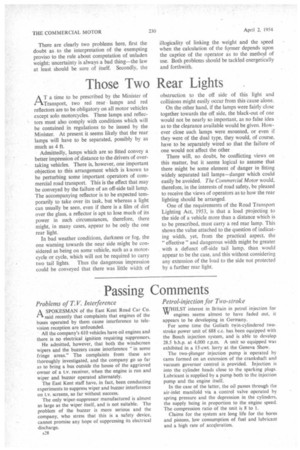Those Two Rear Lights
Page 30

If you've noticed an error in this article please click here to report it so we can fix it.
AT a time to be prescribed by the Minister of Transport, two red rear lamps and red reflectors are to be obligatory on all motor vehicles except solo motorcycles. These lamps and reflectors must also comply with conditions which will be contained in regulations to be issued by the Minister. At present it seems likely that the rear lamps will have to be separated, possibly by as much as 4 ft.
Admittedly, lamps which are so fitted convey a better impression of distance to the drivers of overtaking vehicles. There is, however, one important objection to this arrangement which is known to be perturbing some important operators of commercial road transport. This is the effect that may be conveyed by the failure of an off-side tail lamp. The accompanying reflector is to be expected temporarily to take over its task, but whereas a light can usually be seen, even if there is a film of dirt over the glass, a reflector is apt to lose much of its power in such circumstances, therefore, there might, in many cases, appear to be only the one rear light.
In bad weather conditions, darkness or fog, the one warning towards the near side might be considered as being on some vehicle, such as a motorcycle or cycle, which will not be required to carry two tail lights. Thus the dangerous impression could be conveyed that there was little width of obstruction to the off side of this light and collisions might easily occur from this cause alone.
On the other hand, if the lamps were fairly close together towards the off side, the black-out of one would not be nearly so important, as no false idea as to the clearance available would be given. However close such lamps were mounted, or even if they were of the dual type, they would, of course, have to be separately wired so that the failure of one would not affect the other There will, no doubt, be conflicting views on this matter, but it seems logical to assume that there might be some element of danger in fitting widely separated tail lamps—danger which could easily be avoided. The Commercial Motor would, therefore, in the interests of road safety, be pleased to receive the views of operators as to how the rear lighting should be arranged.
One of the requirements of the Road Transport Lighting Act, 1953, is that a load projecting to the side of a vehicle more than a distance which is to be prescribed, must carry a red rear lamp. This shows the value attached to the question of indicating width, yet, from the practical aspect, the " effective " and dangerous width might be greater with a defunct off-side tail lamp. than would appear to be the case, and this without considering any extension of the load to the side not protected by a further rear light.








































































































